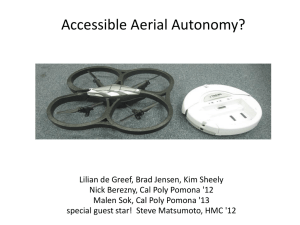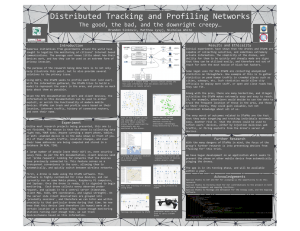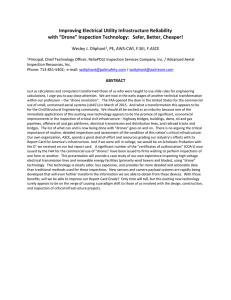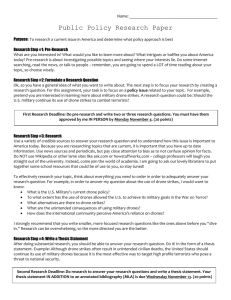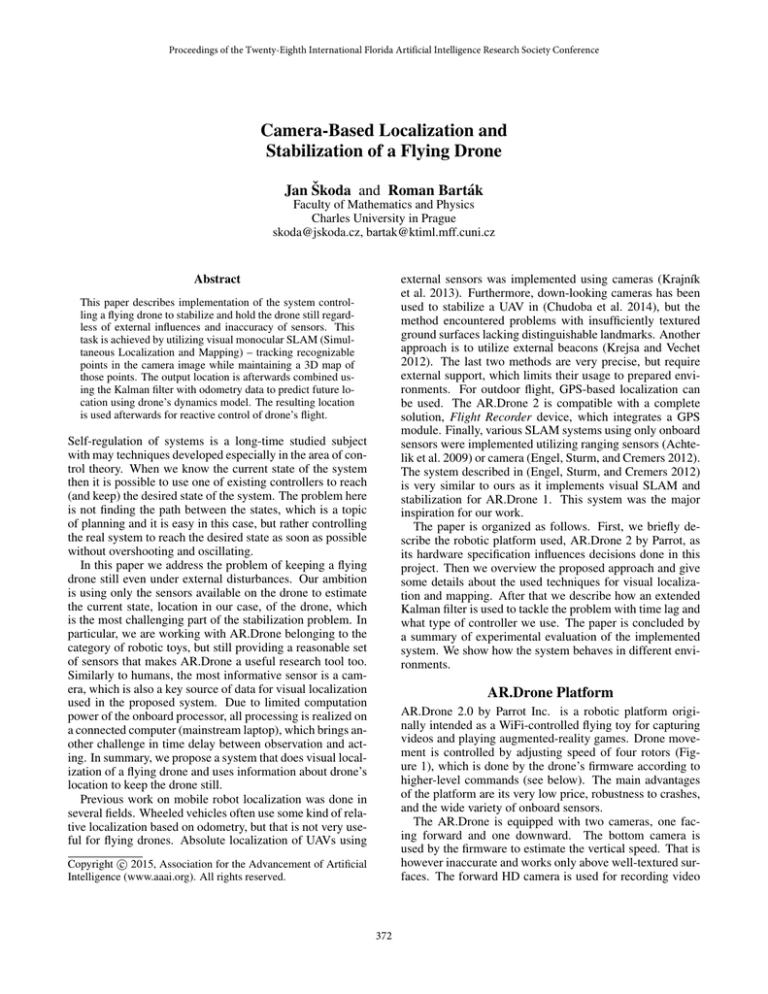
Proceedings of the Twenty-Eighth International Florida Artificial Intelligence Research Society Conference
Camera-Based Localization and
Stabilization of a Flying Drone
Jan Škoda and Roman Barták
Faculty of Mathematics and Physics
Charles University in Prague
skoda@jskoda.cz, bartak@ktiml.mff.cuni.cz
Abstract
external sensors was implemented using cameras (Krajnı́k
et al. 2013). Furthermore, down-looking cameras has been
used to stabilize a UAV in (Chudoba et al. 2014), but the
method encountered problems with insufficiently textured
ground surfaces lacking distinguishable landmarks. Another
approach is to utilize external beacons (Krejsa and Vechet
2012). The last two methods are very precise, but require
external support, which limits their usage to prepared environments. For outdoor flight, GPS-based localization can
be used. The AR.Drone 2 is compatible with a complete
solution, Flight Recorder device, which integrates a GPS
module. Finally, various SLAM systems using only onboard
sensors were implemented utilizing ranging sensors (Achtelik et al. 2009) or camera (Engel, Sturm, and Cremers 2012).
The system described in (Engel, Sturm, and Cremers 2012)
is very similar to ours as it implements visual SLAM and
stabilization for AR.Drone 1. This system was the major
inspiration for our work.
The paper is organized as follows. First, we briefly describe the robotic platform used, AR.Drone 2 by Parrot, as
its hardware specification influences decisions done in this
project. Then we overview the proposed approach and give
some details about the used techniques for visual localization and mapping. After that we describe how an extended
Kalman filter is used to tackle the problem with time lag and
what type of controller we use. The paper is concluded by
a summary of experimental evaluation of the implemented
system. We show how the system behaves in different environments.
This paper describes implementation of the system controlling a flying drone to stabilize and hold the drone still regardless of external influences and inaccuracy of sensors. This
task is achieved by utilizing visual monocular SLAM (Simultaneous Localization and Mapping) – tracking recognizable
points in the camera image while maintaining a 3D map of
those points. The output location is afterwards combined using the Kalman filter with odometry data to predict future location using drone’s dynamics model. The resulting location
is used afterwards for reactive control of drone’s flight.
Self-regulation of systems is a long-time studied subject
with may techniques developed especially in the area of control theory. When we know the current state of the system
then it is possible to use one of existing controllers to reach
(and keep) the desired state of the system. The problem here
is not finding the path between the states, which is a topic
of planning and it is easy in this case, but rather controlling
the real system to reach the desired state as soon as possible
without overshooting and oscillating.
In this paper we address the problem of keeping a flying
drone still even under external disturbances. Our ambition
is using only the sensors available on the drone to estimate
the current state, location in our case, of the drone, which
is the most challenging part of the stabilization problem. In
particular, we are working with AR.Drone belonging to the
category of robotic toys, but still providing a reasonable set
of sensors that makes AR.Drone a useful research tool too.
Similarly to humans, the most informative sensor is a camera, which is also a key source of data for visual localization
used in the proposed system. Due to limited computation
power of the onboard processor, all processing is realized on
a connected computer (mainstream laptop), which brings another challenge in time delay between observation and acting. In summary, we propose a system that does visual localization of a flying drone and uses information about drone’s
location to keep the drone still.
Previous work on mobile robot localization was done in
several fields. Wheeled vehicles often use some kind of relative localization based on odometry, but that is not very useful for flying drones. Absolute localization of UAVs using
AR.Drone Platform
AR.Drone 2.0 by Parrot Inc. is a robotic platform originally intended as a WiFi-controlled flying toy for capturing
videos and playing augmented-reality games. Drone movement is controlled by adjusting speed of four rotors (Figure 1), which is done by the drone’s firmware according to
higher-level commands (see below). The main advantages
of the platform are its very low price, robustness to crashes,
and the wide variety of onboard sensors.
The AR.Drone is equipped with two cameras, one facing forward and one downward. The bottom camera is
used by the firmware to estimate the vertical speed. That is
however inaccurate and works only above well-textured surfaces. The forward HD camera is used for recording video
c 2015, Association for the Advancement of Artificial
Copyright Intelligence (www.aaai.org). All rights reserved.
372
That would however limit the usage of the system to carefully prepared environments. Another attempt to evade the
necessity of SLAM implementation would be to use only
relative localization techniques such as optical flow tracking or acceleration-based speed estimation. Such techniques
are however unable to eliminate drift and localization error
grows over time, so the techniques are applicable just for a
limited time.
For visual localization, we use a system based on the
PTAM library (Klein and Murray 2007). The system receives a video frame at 30 Hz together with a pose prediction based on previous state estimation. It outputs the mostlikely pose estimate of the drone relative to the starting position together with the precision specifier. That position is
processed in an Extended Kalman Filter (EKF) (Welch and
Bishop 1995) together with other measurements received in
navdata such as speed estimate. When the visual tracking
is considered lost, the EKF ignores the visual pose estimate
and predicts the relative pose change from navdata only.
Figure 1: AR.Drone and its coordinate system and angles.
(Krajnı́k et al. 2011)
on attached USB flash storage and/or streaming the video
over a WiFi network. The video stream is unfortunately
aggressively compressed and especially during movement
heavily blurred. The drone is further equipped with a 3-axis
gyroscope, a 3-axis accelerometer, and a magnetometer. Altitude is measured using an ultrasound sensor and a pressure
sensor, which is used in higher altitudes out of the ultrasound
sensor’s range.
The drone contains a control board with a 1 GHz ARM
Cortex processor running a minimalistic GNU/Linux system. It is technically possible to run own programs directly
onboard, but because of the computing power required to
process the video we use an external computer to control the
drone remotely. The AR.Drone creates a WiFi access point
with a DHCP server, so that the controlling device can easily connect and communicate using UDP connections. The
flight is generally controlled just by sending pitch and roll
angles and vertical and yaw speed. The commands are sent
at 30 Hz and the drone’s firmware then tries to reach and
maintain given values until the next command arrives. Data
from non-visual sensors, so-called navdata, are sent from
the drone at 15-200 Hz depending on setting and contains especially roll and pitch angles, azimuth, altitude, and a speed
vector in the drone centered coordinate system (Figure 1).
The network latency of transmission of those commands and
data is approximately 60 ms.
The video from the front camera is (in the default setting) downscaled to 640x360 px, encoded using H.264 with
a maximum bitrate of 4 Mbps and streamed over UDP at
30 FPS. The latency between capturing the image and receiving it at the drone’s board is about 120 ms.
Figure 2: Visualization of the map and the drone’s pose. Red
landmarks are those currently observed.
EKF contains a probabilistic motion-model of the drone’s
flight dynamics and it is an important addition to the visual
localization for several reasons. It combines the visual pose
estimate with other measurements to increase the estimate
precision and maintains it even when the visual system fails
and no absolute pose is measured. Finally, EKF is able to accurately predict drone’s movement for a short time, which is
used to balance the long network latency. The control commands executed on the drone are based on almost 0.2 s old
data. That would result in inaccurate motion and oscillation
around the stabilization position. EKF solves that problem
by providing a 0.2 s prediction of the pose to the control
system.
The usage of a single camera introduces several challenges for the SLAM system. It is possible to estimate the
bearing of a point in a video frame with the knowledge of the
camera model (focal length, distortion parameters), but the
distance of the point can not be measured. That is a problem
when we want to add an observed landmark to the map. For
that we need more observations of the same landmark from
different positions (Figure 3). That is a problem when the
drone is stabilized, as the distance of positions (and the angle γ in the Figure 3) is small and the estimated distance is
Overview of the approach
This work utilizes SLAM (Simultaneous Localization and
Mapping) techniques to localize the drone and stabilize it in
a desired position. There are many other approaches to the
localization problem such as using a GPS signal or artificial markers or transmitters distributed in the environment.
373
Figure 3: Localization of a landmark in 2D.
Figure 4: Graph representation of the internal map.
inaccurate. We have therefore decided, that the map will be
prepared before the stabilization (but possibly after takeoff)
as the localization quality strongly depends on the precision
of the map.
The built-in camera is unable to provide directly the scale
of distances in the picture compared to the real world. This
scale is required for the control system to measure the distance to the desired position on which the approach speed
depends. The scale can be estimated using other measurements of movement in the navdata (Engel, Sturm, and Cremers 2012), but in this work, we estimate the scale during
initialization of the visual localization system, which is required for inserting the first landmarks into the map.
When the system knows the drone’s and the desired poses,
it uses PID controllers to reach and maintain the pose. One
controller is utilized for each coordinate of the 3D position
and for the azimuth.
first landmarks in the map and their positions are calculated
using the five point algorithm (Stewenius, Engels, and Nistér
2006). This procedure requires the user to press a keyboard
button to insert the first keyframe into the map, move the
drone 10 cm to the right and press the button again to insert the second keyframe. The distance must be known by
the system and can be arbitrary, but too small translation
compared to scene depth would result in worse precision
(small angle γ in Figure 3) of the triangulation. The scale
of the map could be estimated using the accelerometer as
well. Unfortunately, the AR Drone 2 does not provide the
acceleration measurements before takeoff.
As mentioned above, landmarks are added to the map only
when a keyframe is inserted. More specifically, a landmark
can be localized only after its second observation, when
the landmark’s location can be measured using triangulation (Figure 3). The two keypoints of observation of a single landmark are associated using epipolar search (Faugeras
1993) and zero-mean SSD (Nickels and Hutchinson 2002)
for their pixel patches. Notice that as the computed location
of the landmark is relative to the location of the drone, the
error of the landmark’s location is affected by the error of
the drone’s location. As the precision of the map is critical
for further localization, we will later describe the means of
improving the precision using subsequent observations.
Visual Localization and Mapping
To estimate a pose of the drone from the received video
frames, our software uses SLAM system based on Parallel Tracking and Mapping method (Klein and Murray 2007)
and this section provides a short overview of the method.
PTAM was developed to track hand-held camera motion in
unknown environment. The tracking and mapping are split
into two tasks processed in separate threads, which can be
run in parallel on a dual-core computer so that computationally expensive batch optimization techniques can be used for
building the map. The resulting system is very robust and
accurate compared to other state-of-the-art systems – in the
cited paper, it was successfully compared to the widely used
EKF-SLAM.
In order to localize the drone, the system maintains a
map of landmarks observed in the environment (Figure 2).
The map is not updated for every frame, only for certain
keyframes. Keyframe composes of a video frame, a set of
keypoints detected by the FAST corner detector (Trajković
and Hedley 1998), and a pose estimation, which can be later
updated in order to increase the precision of the pose and
therefore even the precision of the associated keypoints locations. The structure of the map is illustrated in Figure 4.
The map has to be initialized before the localization. This
is done by inserting first two keyframes which define the origin of the coordinate system and its scale to the real world.
The points observed in those keyframes are then used as the
Camera Pose Estimation
Having the map, we can compare it with landmarks observed
in every frame to localize the drone. In this section we will
briefly describe how this is done.
Assume that we have a calibrated pin-hole camera projection model CamP roj:
x
ui
y
= CamP roj
(1)
vi
z
1
Where x, y, z are the coordinates of a landmark relative to
the current camera pose and ui , vi are the (pixel) coordinates
of the landmark projection into the image plane of the camera. Let CameraP oseT rans(µ, pi ) denote the location of
the landmark pi relatively to the camera pose µ. We can
use the defined projection to express the reprojection error
vector ej of the landmark with coordinate vector pj (relative
to the map origin) which was observed at uj , vj . Reprojection error is the difference between where the landmark pj
374
should be observed according to the map, if the drone’s pose
is µ, and where it was observed using the camera.
Similarly, measurements are perceived as a normal distribution of Z with the mean value equal to the received measurement. Its covariance matrix is usually fixed and represents
the precision of sensors. Finally, EKF receives a control vector, which describes the command sent to the drone. Relation between two subsequent states and the control vector u
is defined by a process model P (Xk |Xk−1 , uk−1 ), relation
between state and measurement is defined by a measurement model P (Zk |Xk ). We will further denote the means
of the state and the measurement at a time k as xk and zk .
Note that the measurement model determines measurements
from states to compare it with received measurements and
not vice versa.
The major task of an EKF utilization is to implement the
process and measurement models. Due to space limit we
will not describe the whole implementation, especially the
motion model, but only the interface of the filter and the
main part of the measurement model. The interface between
the EKF and the control system is composed mostly of the
vectors xk , zk and uk :
uj
− CamP roj(CameraP oseT rans(µ, pj ))
vj
(2)
In the correct pose of the drone, the reprojection errors
should be very small. Therefore we can use ej for finding
the most-likely camera pose µ0 :
X
ej
µ0 = argmin
Obj
, σT
(3)
σj
µ
ej =
j∈S
where S denotes the set of landmark observations,
Obj(·, σT ) is the Tukey biweight objective function (Hampel, Ronchetti, and Rousseeuw 1986), and σT is a robust
estimate of the distribution’s standard deviation.
Mapping
Mapping is a process of adding newly observed landmarks
into the map and updating the pose of known landmarks after further observations in order to improve the precision of
their location. All mapping operations, which can be computationally expensive, are done in a separate thread.
We have already outlined the process of keyframe addition, in which the landmarks are added to the map. When
the mapping thread doesn’t work on that, the system use the
spare time to improve the accuracy of the map. The position of a landmark is initially computed from its first two
observations. We can improve that by minimizing the reprojection error of the landmark’s location for all observations
and landmarks.
Assume that we have N keyframes {1, ..., N }. In each of
them, we observed a landmark set Si , which is a subset of a
set {1, ..., M } of all M landmarks. We will denote the jth
landmark observed in some keyframe i with the subscript
ji. µi is the pose of a keyframe i and pj is the location
of a landmark j. Bundle adjustment is then used to update
the poses of keyframes and the locations of landmarks (in a
similar way as in the equation 3):
• xk = (x, y, z, vx , vy , vz , φ, θ, ψ, dψ) – 3D coordinates
relative to map origin, 3D speed vector in the same system, roll, pitch, yaw and yaw rate
• uk = (φ̄, θ̄, ψ̄, v¯z ) – desired roll, pitch, yaw and yaw rate
as sent to the drone
• zk = (vx0 , vy0 , vz0 , φ, θ, ψ, x, y, z) – measured speed in 3D
coordinates relative to the drone (Figure 1), roll, pitch,
yaw and the drone’s coordinates in 3D from the visual
localization system
The measurement model is used to correct the filter’s prediction of the process state xk according to the obtained
measurement. The main part of the model is a function
zk = g(xk ), which is used to compute the expected measurement to be compared with the measurement obtained
from the drone.
0
vx
vx cos ψ − vy sin ψ
0
vy
vx sin ψ − vy cos ψ
v 0
vz
z
φ
φ
θ = g(xk ) =
θ
(5)
ψ
ψ
x
x
y
y
z
z
{{µ2 , ..., µN }, {p01 , ..., p0M }} =
argmin
N X
X
{{µ},{p}} i=1 j∈S
Obj
eji
, σT
σji
(4)
Together with the function g, the measurement model
contains a covariance matrix, which specifies the precision
of sensors. When the visual localization system fails for a
moment, the variances of it’s output, location (x, y, z), are
increased, so that the filter practically ignores the measurements (x, y, z) and updates the pose of the drone according
to the process model and the other measurements.
Note that the pose of the first keyframe is fixed in the origin of the map, hence µ2 .
Extended Kalman Filter
We employ an Extended Kalman Filter (EKF) (Welch and
Bishop 1995) for state-from-measurements estimation. Its
goals are noise filtering, processing multiple measurements
of a single variable, and prediction of the state of the system
in the near future. The extended version of KF is necessary
due to the nonlinear nature of the drone’s flight dynamics.
EKF stores the state as a (multivariate) normal distribution of X represented by its mean and covariance matrix.
Drone Control
The control system receives the most-likely state prediction
xt , computes the control command from xt and sends it to
the drone for execution. The time t is the time of receiving
375
sensor measurements used to estimate xt plus the expected
latency after which the command will be executed on the
drone. This way, the drone will react to its current pose and
not to some older one.
The control command is obtained using four independent
PID (proportional-integral-derivative) controllers for each
degree of freedom: x, y, z, yaw. Let e(t) denote the error
of the controlled variable at time t. Then the output out(t)
of the PID controller is calculated according to the following
classical formula:
Z
out(t) = P · e(t) + I ·
t
e(t)dt + D ·
0
de(t)
dt
The measurement was done in several different environments with distinct number of detected landmarks, both in
interiors and exteriors. The following tables summarize the
results of the experiments:
Name
Environment
Keypoints
Measured error
(6)
where P , I and D are parameters (weights) of the controller
which have to be tuned. They describe the reaction of the
controller to the error (P), the integrated error (I), and the
speed of change of the error (D). Note that after initial testing of the system, we have set the I parameter to zero in
order to prevent the wind-up effect and overshooting.
From each of the four controllers we obtain a desired
change of controlled variables: xd , yd , zd and yawd . As
the coordinates are relative to the map origin, we have to
rotate xd , yd to the drone-centric coordinate system (Figure
1). Then we construct the control command ut – we use
xd , yd as the two tilt angles of the drone, zd as the vertical speed and yawd as the rotational speed. Therefore
ut = (xd , yd , yawd , zd ).
The visual localization was lost
between the initialization and
takeoff as the drone laid on the
floor was not able to observe
the scene. However, after takeoff the localization was immediately restored. Error fluctuated, but did not show a trend
to grow in time.
Name
Environment
House frontage
Visually poor environment,
enough light, light wind
approx. 100
10 cm
Notes
Evaluation
Name
Environment
Keypoints
Measured error
Notes
Name
Environment
1. The visual localization system is initialized.
2. Several keyframes (around five) are inserted manually.
3. The gyroscope is calibrated.
Keypoints
Measured error
4. We manually fly with the drone to a desired position and
enable the stabilization. The orthogonal projection of the
drone’s location to the floor is marked on the floor. We
used a pendulum to do that.
Notes
5. We push the drone approximately 20 cm aside.
6. After 20 s, we mark the drone’s location on the floor again
and measure the distance, which is stated in the following
tables as the Measured error.
Note that we didn’t measure the yaw or the altitude. It
would only make the measurement longer, less precise and
would not bring any new information, as the precision of
the yaw and the altitude will be similar (or better thanks to
the altimeter and the compass) than the precision of the x, y
coordinates.
environment,
Notes
Keypoints
Measured error
The performance and robustness of the system was experimentally evaluated by examination of the ability of the system to stabilize the drone in a given position. A series of
measurements was made in various environments. As we
unfortunately did not have any device capable of recording the true location of the drone (ground truth), we had to
record and measure the results by hand. The measurements
were performed according to this scheme:
College room
Visually rich
small interior
approx. 200
7 cm
The system maintained the localization. It was however almost unable to find any keypoint on the wall of the house.
Gymnasium
Big room, artificial light
approx. 50
3 cm
Bare wall and radiator
Visually very poor environment, repeated patterns
approx. 15
We managed to initialize the localization system, but the drone
held in the desired position just
for a few seconds and the measurement had to be aborted.
Some landmarks created on the
surface of the radiator were often observed in another parts
of the radiator, which disrupted
the localization.
The video demonstrating the system and showing its user
interface can be found at http://vimeo.com/102528129.
376
Conclusion
Krajnı́k, T.; Nitsche, M.; Faigl, J.; Duckett, T.; Mejail, M.;
and Přeučil, L. 2013. External localization system for mobile robotics. In Proceedings of the International Conference on Advanced Robotics, Montevideo.
Krejsa, J., and Vechet, S. 2012. Infrared beacons based
localization of mobile robot. Elektronika ir Elektrotechnika
117(1):17–22.
Nickels, K., and Hutchinson, S. 2002. Estimating uncertainty in ssd-based feature tracking. Image and vision computing 20(1):47–58.
Stewenius, H.; Engels, C.; and Nistér, D. 2006. Recent
developments on direct relative orientation. ISPRS Journal
of Photogrammetry and Remote Sensing 60(4):284–294.
Trajković, M., and Hedley, M. 1998. Fast corner detection.
Image and vision computing 16(2):75–87.
Welch, G., and Bishop, G. 1995. An introduction to the
kalman filter. In Annual Conference on Computer Graphics
and Interactive Techniques, 12–17.
The goal of the work is to implement a system able to stabilize the drone using localization techniques. The flying
drone has to hold still regardless of external influences, inaccuracy of sensors, and the latency of control. As we wanted
the stabilization to work accurately for longer periods of
time, we had to avoid the effect of accumulated error typical
for relative localization. Therefore we decided to implement
a visual SLAM system.
As the used AR.Drone has no stereo-vision camera, the
system has to be able to estimate the distances of observed
objects from multiple observations from different locations.
That is complicated by the fact, that the goal of the system
is to hold at one particular location, so we have to prepare a
localization map before activation of the stabilization. The
method also assumes that the environment is mostly static
and contains detectable visual landmarks (e.g. a room containing only plain walls is problematic).
The robustness and precision of our method was evaluated by conducting an experiment consisting of several measurements in various environments. In the experiment we
showed, that our system is able to stabilize the drone surprisingly well despite the poor quality of the video, which is
generated by the chosen low-cost platform.
Acknowledgements
Research is supported by the Czech Science Foundation under the project P103-15-19877S.
References
Achtelik, M.; Bachrach, A.; He, R.; Prentice, S.; and Roy,
N. 2009. Stereo vision and laser odometry for autonomous
helicopters in gps-denied indoor environments. In SPIE Defense, Security, and Sensing, volume 7332. International Society for Optics and Photonics.
Chudoba, J.; Saska, M.; Baca, T.; and Přeučil, L. 2014.
Localization and stabilization of micro aerial vehicles based
on visual features tracking. In Unmanned Aircraft Systems
(ICUAS), 2014 International Conference on, 611–616.
Engel, J.; Sturm, J.; and Cremers, D. 2012. Camera-based
navigation of a low-cost quadrocopter. In Intelligent Robots
and Systems (IROS), 2012 IEEE/RSJ International Conference on, 2815–2821. IEEE.
Faugeras, O. 1993. Three-dimensional computer vision: a
geometric viewpoint. MIT press.
Hampel, F.; Ronchetti, E.; and Rousseeuw, P. 1986. Robust
statistics: the approach based on influence functions. Wiley
series in probability and mathematical statistics.
Klein, G., and Murray, D. 2007. Parallel tracking and mapping for small ar workspaces. In Mixed and Augmented Reality, 2007. ISMAR 2007. 6th IEEE and ACM International
Symposium on, 225–234. IEEE.
Krajnı́k, T.; Vonásek, V.; Fišer, D.; and Faigl, J. 2011.
Ar-drone as a platform for robotic research and education.
In Research and Education in Robotics-EUROBOT 2011.
Springer. 172–186.
377


